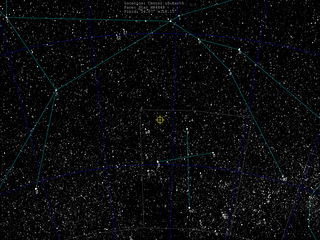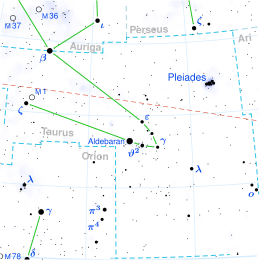ω1 Scorpii, Latinised as Omega1 Scorpii, is a star in the zodiac constellation of Scorpius. With an apparent visual magnitude of 3.95 it can be seen with the naked eye, 0.22 degree north of the ecliptic. Parallax measurements of this star give an estimated distance of around 470 light years from the Sun. It is a member of the Scorpius–Centaurus association.
6 Andromedae is an astrometric binary star system in the northern constellation of Andromeda. The designation comes from the star catalogue of John Flamsteed, first published in 1712. Its apparent visual magnitude is 5.91, which is just bright enough to be visible to the naked eye under good seeing conditions. Based upon an annual parallax shift of 34.1 mas as seen from Earth, it is around 96 light years from the Sun. It is moving closer to the Sun with a radial velocity of −32.4 km/s. The system has a relatively high proper motion, advancing across the celestial sphere at the rate of 0.272 arc seconds per annum.

20 Aquilae, abbreviated 20 Aql, is an irregular variable star in the equatorial constellation of Aquila. 20 Aquilae is its Flamsteed designation. It ranges in magnitude from a peak of 5.33 down to 5.36, which is bright enough for the star to be visible to the naked eye. The estimated distance to this star is around 920 light years, based upon an annual parallax shift of 3.5 mas. The star is moving closer to the Earth with a heliocentric radial velocity of −23 km/s.
18 Boötis is a single star in the northern constellation of Boötes, located about 85 light years away from the Sun. It is visible to the naked eye as a faint, yellow-white hued star with an apparent visual magnitude of 5.41. This object is a suspected member of the Ursa Major Moving Group, based on velocity criteria. It has a magnitude 10.84 optical companion at an angular separation of 163.7″ along a position angle of 219°, as of 2010.
32 Boötis is a single star in the northern constellation of Boötes, located 360 light years away from the Sun. It is visible to the naked eye as a faint, yellow-hued star with an apparent visual magnitude of 5.55. This object is moving closer to the Earth with a heliocentric radial velocity of −23 km/s. It has a relatively high proper motion, traversing the celestial sphere at the rate of 0.195 arc seconds per annum.
Lambda Canis Majoris is a solitary, blue-white hued star in the constellation Canis Major. Lambda CMa is visible to the naked eye with an apparent visual magnitude of +4.48. Based upon an annual parallax shift of 7.70 mas as seen from Earth, this star is located about 424 light years from the Sun. At that distance, the visual magnitude is diminished by an extinction of 0.14 due to interstellar dust.

HD 19275 is a single star in the northern constellation of Cassiopeia. It has a white hue and is faintly visible to the naked eye with an apparent visual magnitude of 4.85. The distance to HD 19275 is 163 light years as determined using parallax measurements. It is drifting further away from the Sun with a radial velocity of around 12 km/s.

22 Scorpii (i Scorpii) is a single star in the southern zodiac constellation of Scorpius, about one degree from Antares. It is faintly visible to the naked eye with an apparent visual magnitude of 4.78. The distance to this star is estimated to be around 410 light years, as derived from its annual parallax shift of 7.89±0.24 mas. The star is embedded in, or adjacent to, the diffuse nebulous cloud IC 4605 located in the western regions of the Rho Ophiuchi cloud complex.

HD 110956 is a single star in the southern constellation of Crux. It is faintly visible to the naked eye with an apparent visual magnitude of 4.62. The distance to this star is approximately 385 light years based on parallax and it is drifting further away with a radial velocity of 15.5 km/s. It is a probable member of the Lower Centaurus–Crux subgroup of the Scorpius–Centaurus association.
Psi Eridani, Latinized from ψ Eridani, is a star in the constellation Eridanus. With an apparent visual magnitude is 4.81, it can be seen with the naked eye on a clear, dark night. Based upon an annual parallax shift of 4.41 milliarcseconds, it is located roughly 740 light-years away from the Sun.
38 Geminorum is a binary star system in the northern zodiac constellation of Gemini. It has the Bayer designation e Geminorum, while 38 Geminorum is the Flamsteed designation. This system is visible to the naked eye as a faint, white-hued point of light with an apparent visual magnitude of 4.71. The primary component is a magnitude 4.75 star, while the secondary is magnitude 7.80. The system is located about 98 light years away from the Sun based on parallax, and is drifting further away with a radial velocity of +16 km/s. It is a potential member of the Tucana–Horologium stellar kinematic group.
Tau1 Hydrae is a triple star system in the equatorial constellation of Hydra. Based upon the annual parallax shift of the two visible components as seen from Earth, they are located about 18 parsecs (59 ly) from the Sun. The system has a combined apparent visual magnitude of +4.59, which is bright enough to be visible to the naked eye at night.
11 Librae is a single, fifth-magnitude star in the southern zodiac constellation of Libra. It is faintly visible to the naked eye with an apparent visual magnitude is 4.93. The star is moving further from the Sun with a heliocentric radial velocity of +83.6 km/s. The distance to this star, as estimated from its annual parallax shift of 14.92±0.40 mas, is about 219 light years.
Phi2 Lupi, Latinized from φ2 Lupi, is a solitary star in the southern constellation of Lupus. With an apparent magnitude of 4.535, it is bright enough to be seen with the naked eye. Based upon an annual parallax shift of 6.28 mas as seen from Earth, it is located around 520 light years from the Sun. At that distance, the visual magnitude of the star is diminished by an extinction factor of 0.052±0.013 due to interstellar dust. It is a member of the Upper Centaurus–Lupus subgroup of the Scorpius–Centaurus association.
HD 202628 is a single star in the southern constellation of Microscopium. It has an apparent visual magnitude of +6.7, which makes it too faint to be readily visible to the naked eye. The star is located at a distance of 77.7 light years from the Sun based on parallax, and it is drifting further away with a radial velocity of +12.1 km/s. The absolute magnitude of this star is 4.86.
HR 4699 is a single star in the southern constellation of Corvus. It is orange in hue and is dimly visible to the naked eye with an apparent visual magnitude of +5.14. This star is located at a distance of approximately 201 light years from the Sun based on parallax. It is drifting further away with a radial velocity of +14 km/s, after come to within 45.1 light-years some four million years ago.
HD 137366 is a solitary blue-hued star located in the southern circumpolar constellation Apus. It has an apparent magnitude of 6.38, placing it near the limit for naked eye visibility, even under ideal conditions. The object is located relatively far at a distance of approximately 1,100 light-years based on Gaia DR3 parallax measurements, but its heliocentric radial velocity is not known. At its current distance, HD 137366's brightness is diminished by three-tenths of a magnitudes due to interstellar extinction and it has an absolute magnitude of −1.54.

32 Tauri is the Flamsteed designation for a solitary star in the zodiac constellation of Taurus. It has a visual magnitude of 5.64, making it visible to the naked eye from suburban skies. The position of this star near the ecliptic plane means that it is subject to occultations by the Moon. Parallax measurements put it at a distance of 144 light years from the Sun. It is drifting further away with a radial velocity of +31.9 km/s, having come to within 88.9 light-years some 759,000 years ago.

HD 111395 is a single, variable star in the northern constellation of Coma Berenices. It has the variable star designation LW Com, short for LW Comae Berenices; HD 111395 is the Henry Draper Catalogue designation. The star has a yellow hue and is just bright enough to be barely visible to the naked eye with an apparent visual magnitude that fluctuates around 6.29. Based upon parallax measurements, it is located at a distance of 55.8 light years from the Sun. The star is drifting closer with a radial velocity of −8.9 km/s. It is a member of the Eta Chamaeleontis stellar kinematic group.
HD 196775 is a solitary star in the equatorial constellation Delphinus. It has an apparent magnitude of 5.98, allowing it to be faintly seen with the naked eye. The object is relatively far at a distance of 1,050 light years but is approaching the Solar System with a heliocentric radial velocity of −4.6 km/s. HD 196775 has a high peculiar velocity of 21.8+1.9
−4.1 km/s compared to neighboring stars, indicating that it may be a runaway star.






